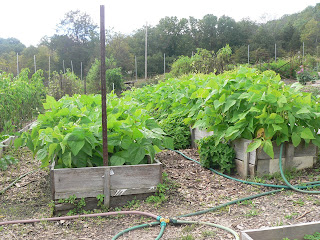As you can see from the blog title we have been introduced to the first ice situation. there was only about 1/10 of an inch of ice but it has caused a major traffic problem. Starting at 7 o'clock last night. We don't live too far from the interstate 44. There was a jackknifed tractor trailer going west on 44 and it backed up the traffic for over 7 miles. The people sat still for over 3 hours polluting the environment (wishing they were already to their destination).
Needless to say with our quarter of a mile drive Hunny is waiting till later to go in to work. Right now he is walking carefully down the drive spreading ashes from the fireplace hoping to give some traction or to start the melting process. Being it is still around 12 degrees in our valley I doubt that is going to happen. The drive is at least a 45 degree slope at the top and at the bottom of the 45 is a left angled turn. If you don't make the turn, you are plowing a furrow down a 60 degree slope.
The garden is covered in the light snow from 3 days ago The ice is sealing the crust. All the barn cats are snuggled in their tents inside the barn. Yes we make little cubby holes for them. They maybe wild, but they keep the snakes and mice away and they use the litter box in the barn so we take care of them. We feed them and there are lots of critters on the ground for them to hunt. We have been very fortunate They do not seem to relish our birds. We only find evidence of less than a bird a month demise.
Wish I had some photos to share,
The bird feeder is quite busy today,
They fly in and out, don't seem to care,
Don't even stop, a thank you to say.
The cardinals threaten the jays,
The chickadees could care less,
The nuthatches just want to play,
While the snowbirds join the fest.
Popcorn and dog food are a woodpeckers treat,
The small birds love what our parrots don't eat,
Fresh water is handy in a bowl near by,
We've only seen little birds give it a try.
Please give feeding them a try,
Black oil sunflower seeds are the best to buy,
They attract the most variety of all the seeds,
Get ready to see fun antics and ridiculous deeds.
Other Blogs by me:
http://glosgarden.blogspot.com/
http://gloriouscreations.blogspot.com/
Other Blogs by me:
http://glosgarden.blogspot.com/
http://gloriouscreations.blogspot.com/










































